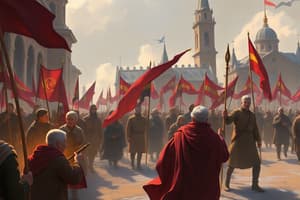Podcast
Questions and Answers
Who were the first nation-states to be established, as depicted in Frederick Marmon's painting?
Who were the first nation-states to be established, as depicted in Frederick Marmon's painting?
- Italy and Spain
- United States and Switzerland (correct)
- England and Scotland
- France and Germany
What was the significance of Frederick Marmon's painting 'Dream of the World'?
What was the significance of Frederick Marmon's painting 'Dream of the World'?
- It symbolized the first nation-states established in the United States and Switzerland
- It portrayed the dream of a unified Europe and the work towards it (correct)
- It represented the economic differences among various nations
- It depicted the rise of nationalism in Europe and the establishment of nation-states
What did viewers miss out on when Tudor Vecomes and Going subscribed to the National Geographic channel?
What did viewers miss out on when Tudor Vecomes and Going subscribed to the National Geographic channel?
- The significance of Frederick Marmon's painting
- The establishment of nation-states
- Other liked videos by Dream of the World, Sher Viet, and Don't Note Forgot (correct)
- The rise of nationalism in Europe
What did the group encourage viewers to do after watching the video?
What did the group encourage viewers to do after watching the video?
What was significant about the rise of nationalism in Europe discussed in the chapter?
What was significant about the rise of nationalism in Europe discussed in the chapter?
Flashcards are hidden until you start studying
Study Notes
-
Yasmin Surabhi Guptha welcomes viewers to the "Tudor Vecomes and Going Too Beeding" challenge in the National Geographic channel, led by Bill Abel and Todd Riesen.
-
The challenge started with Tudor Vecomes and Going subscribing to the channel and missing out on other liked videos by Dream of the World, Sher Viet, and Don't Note Forgot.
-
The group then encouraged viewers to share a drink with someone if the video resonated with them.
-
The chapter discusses the rise of nationalism in Europe and the establishment of nation-states, starting with Frederick Marmon's painting "Dream of the World" from 1848.
-
The painting depicts Frederick Marmon, a Democratic and Social Republican from the US, and a chart showing various nations and their economies.
-
The painting was significant because the United States and Switzerland were the first nation-states to be established, and revolutions had already taken place in France and Germany, where many nations were yet to become nation-states.
-
The group then goes through the entire painting, explaining the significance of each section, and that the painting is an invitation to imagine a unified Europe, despite the differences among nations and their monarchs.
-
This chapter was started because the painters wanted to show the dream of a unified Europe that many people in Europe held, and which they were working towards.
-
Yasmin Surabhi Guptha welcomes viewers to the "Tudor Vecomes and Going Too Beeding" challenge in the National Geographic channel, led by Bill Abel and Todd Riesen.
-
The challenge started with Tudor Vecomes and Going subscribing to the channel and missing out on other liked videos by Dream of the World, Sher Viet, and Don't Note Forgot.
-
The group then encouraged viewers to share a drink with someone if the video resonated with them.
-
The chapter discusses the rise of nationalism in Europe and the establishment of nation-states, starting with Frederick Marmon's painting "Dream of the World" from 1848.
-
The painting depicts Frederick Marmon, a Democratic and Social Republican from the US, and a chart showing various nations and their economies.
-
The painting was significant because the United States and Switzerland were the first nation-states to be established, and revolutions had already taken place in France and Germany, where many nations were yet to become nation-states.
-
The group then goes through the entire painting, explaining the significance of each section, and that the painting is an invitation to imagine a unified Europe, despite the differences among nations and their monarchs.
-
This chapter was started because the painters wanted to show the dream of a unified Europe that many people in Europe held, and which they were working towards.
Studying That Suits You
Use AI to generate personalized quizzes and flashcards to suit your learning preferences.




